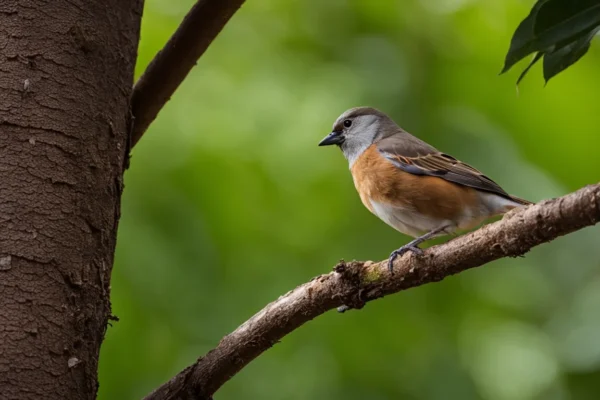If you’re a homeowner, you may have noticed your flowerbeds or grass have strange holes in it. What are the ravenous birds in your yard nibbling on? You may analyze damage and attract more beneficial birds to your outdoor area by identifying the offenders.
Here’s the short response in case you’re pressed for time: Grackles searching for insects, crows tearing up turf to get grubs underneath, starlings nibbling grass stems, and robins devouring worms and grubs are common birds that cause harm to lawns.
We’ll go over the eating patterns of several bird species and what they imply for your grass in this extensive tutorial. You’ll discover how to utilize visual cues to determine the root cause of grass damage. We’ll also provide advice on how to deter troublesome birds while drawing in pest-eradicating species by nature.
Robins
Because of their well-known predilection for worms and other insects, robins are often seen in lawns. These birds can hear quite well, so they can pick up even the smallest movement under the surface. With the help of their keen beaks, robins dig into the ground to find their meal.
Although their main food source is worms, they also consume beetles, caterpillars, and grubs. They are thus useful friends in the fight against plant pests.
Starlings
In addition to eating worms and insects, starlings may harm lawns. These birds are recognized for their gregarious eating habits and large groups. They scoop up insects and worms by using their powerful beaks to delve into the earth.
Their eating habits, however, sometimes cause soil to be flipped over in spots causing harm to grass roots. Although starlings aid in the management of pests, their eating habits may cause damage to lawns.
Grackles
Another group of birds that eats insects and worms are the grackles. These birds explore lawns for food with their long, pointed beak. As opportunistic feeders, grackles will consume a wide range of insects, including grasshoppers, beetles, and ants.
Even while they are less frequent than starlings or robins, their eating habits may nevertheless harm lawns, particularly if they congregate in large groups.
Thrushes
Thrushes are great hunters of worms and insects; one example of this is the American Robin. They sprint a few feet and then pause to listen for any noises of movement in the earth, which is a characteristic activity. They promptly use their beaks to retrieve worms and insects from the ground after seeing food.
By regulating the number of worms and insects, thrushes are vital to the upkeep of a thriving grass environment.
You may visit the All About Birds website, which offers extensive information on different bird species and their eating patterns, for additional details on bird diets and their effects on lawns.
Sparrows
Sparrows are legendary seed eaters and are often seen in gardens and lawns. A wide range of seeds, including grass, weed, and even floral seeds, are part of their varied diet. Lawns with plenty of seed heads or those that have just been planted tend to attract sparrows more.
Because of their eating habits, the grass may sustain harm when they remove the seeds and leave behind barren areas. By taking precautions to keep sparrows off your lawn, you can preserve your seeds and encourage strong grass growth.
Finches
Another group of birds that are well-known for eating seeds are finches. With the help of their powerful beak, they can split open seeds and take out the essential material. Sunflower seeds, which are often seen in bird feeders, are particularly beloved by finches.
They have been seen to consume weed and grass seeds from lawns, however. Little holes where they have buried seeds in the grass may result from their feeding activities. Offering substitute food sources, such as bird feeders situated away from the grass, may assist in deflecting their focus and reducing harm to your lawn.
Juncos
Known by many as “snowbirds,” juncos are tiny birds that mostly eat seeds. They like to graze on the ground, and you may often see them searching lawns and gardens for dropped seeds. The diverse diet of Juncos includes plant, grass, and weed seeds.
Because of their eating habits, lawns may have areas of bare soil, particularly in the winter when there are fewer alternative food sources. You may lessen their effect on the beauty of your lawn by designating certain feeding places that are apart from the grass.
It’s vital to remember that while these birds could harm your grass, they are essential to preserving the ecosystem’s equilibrium. Birds disperse seeds, manage pest populations, and enhance backyard biodiversity in general.
By putting into practice bird-friendly techniques, including installing bird baths and growing native plants that may bear seeds, you can foster a peaceful atmosphere where birds can flourish without doing undue harm to your grass.
Blue Jays
In addition to their vivid blue feathers, blue jays are recognized for their affinity for fruits and nuts. These perceptive birds are often seen in residential settings, particularly on lawns, where they forage for tree nuts such as acorns and hazelnuts.
They also take great pleasure in gorging on berries, including raspberries, blackberries, and blueberries. It is well known that blue jays stash their food in different places. They have been seen to burrow nuts and cache berries for future use. They are able to endure the winter months when food supplies are limited because of this habit.
The Woodpeckers
With their characteristic drumming noises, woodpeckers are skilled hunters who mostly consume fruits and nuts. These birds love nuts and fruits, but they can even drill into tree trunks to retrieve insects thanks to their powerful beaks.
Suet feeders containing nuts and seeds attract woodpeckers in particular. They also take pleasure in gorging on fruit, including dogwood and elder berries. Their food contributes to the development and variety of plant life by giving them vital nutrients and assisting in the dispersal of seeds.
The Orioles
Orioles are well-known for their affinity for fruits and nectar, as well as their vivid orange and black feathers. Oranges, grapefruits, and other citrus fruits are especially appealing to these birds since they have a sweet appetite. They also take pleasure in drinking nectar from feeders and flowers.
Orioles may be drawn to your lawn by placing a feeder with orange slices or providing a sugar water solution. Because they spread pollen from one flower to another while consuming nectar, orioles are crucial to the pollination process, which ensures the survival of several plant species.
Identifying Bird Damage to the Lawn
Having to deal with bird damage may be annoying when it comes to keeping up a lovely lawn. But, you can more effectively identify the offenders and take the necessary action if you are aware of the many lawn damage kinds that birds may do. The following are typical indicators to be aware of:
Disperse Holes from Examining
Scatter holes are among the most obvious indicators of bird damage in lawns. Probing the ground for insects, worms, and grubs is a common behavior of birds such as blackbirds and robins. Your grass may have a few tiny, shallow holes from these probing operations.
These scatter holes are an obvious sign that birds are looking for food in your yard.
Ruptured Turf Patches
Torn-up areas of grass are another obvious indicator of bird damage. Some birds, like starlings and crows, like to nibble at the grass, bringing it up in the process. This may cause your lawn to have ugly spots where the grass has been pulled up and the exposed dirt is visible.
If you see these ripped-up areas, birds are probably to blame for the damage.
Cleanly Cut Grass Blades
Despite the fact that it can appear strange, several bird species carefully cut off grass blades. The European starling is the most infamous offender in this context. These birds will clip the tops of the grass blades so that it looks well-trimmed.
This kind of damage is a clear sign that starlings are there and eating your grass if you see it in your yard.
You may create a plan to discourage the kind of bird that is damaging your grass by determining what kind of bird it is. To deter probing birds from foraging in your yard, for instance, you may want to use physical obstacles like bird netting or scare techniques like hanging reflecting items.
Consider using visual deterrents like scarecrows or motion-activated sprinklers to prevent birds that eating areas of grass on your lawn. Furthermore, if well-clipped grass blades are the problem, think about using bird repellents or making your surroundings less alluring to European starlings.
Recall that preventing bird harm requires a method that is both ecologically and humanely sound. You may discover practical solutions that safeguard your lawn and the birds themselves by learning about the habits and nutritional preferences of various bird species.
Keeping Out Invading Birds and Bringing in Beneficial Species
It might be annoying to deal with nuisance birds on your lawn, but there are ways to discourage them and promote the presence of healthy bird species. You may minimize damage to your grass while fostering a bird-friendly habitat by combining several tactics.
Eliminating Food Sources
Eliminating the food sources that draw nuisance birds to your lawn is one of the first steps in keeping them away. This may include any trash that may be left out in the open, as well as dropped fruits and seeds. You may deter nuisance birds from visiting your home by keeping your grass tidy and devoid of any possible food sources.
A National Audubon Society research found that eliminating food sources is a critical component in lowering bird damage in residential settings. They discovered that homeowners may greatly reduce the number of nuisance birds on their lawns by getting rid of readily available food.
Employing Fear Techniques
Using scare methods to keep nuisance birds off your lawn may work well. You may experiment with a number of strategies, including predator decoys, noisemakers, and visual deterrents. Pest birds are discouraged from using these fear techniques and are instead encouraged to look for other places to nest and forage.
To maximize their impact, the Cornell Lab of Ornithology advises combining several scare techniques. You may keep birds from becoming acclimated to scare devices and increase their effectiveness in repelling pests by switching up their location and design on a regular basis.
Offering Substitute Feeding Stations
Offering substitute feeding stations made just for desirable bird species is one method to keep problem birds off your lawn. Offering a range of bird feeders filled with various foods can draw in beneficial birds that will aid with organic pest management.
The National Wildlife Federation advises setting up bird feeders in locations other than your lawn to entice birds to forage there. This may lessen the likelihood of pest birds taking over in a balanced environment.
Never forget that using these tactics will need patience. It can take some time for the targeted bird species to adjust to the environmental changes. You may successfully ward off problem birds and attract good species to your lawn by combining these techniques and establishing an environment that is conducive to birds.
Final Thoughts
You may take action to discourage or invite certain types of birds to your lawn by determining if worms, seeds, or fruits are drawing them in. Some birds offer free pest management, while others trample grass in search of grubs and insects.
You may make sensible habitat adjustments and turn your lawn into a bird-friendly area by learning about avian diets.


![Where Do Owls Sleep? [A Comprehensive Guide]](https://birdsology.com/wp-content/uploads/2023/09/15195890788_b2d8b907ef_b-600x400.jpg)



